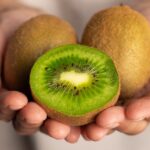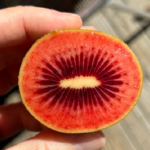Zespri's five-year plan for New Zealand kiwifruit

New Zealand kiwifruit icon Zespri raised sales of its new centerpiece variety four-fold this year in its biggest export destination, with recent upticks as well on forecasts for average grower returns and total volume. While a legal conflict at home has led to divisive faction lines through the industry, the single desk marketer has been kicking goals overseas in an emptier market with less Chilean supply, backed by grassroots consumer campaigns and an emphasis on health benefits. 
Best Attire was the award given to Team Zespri at this year's Produce Marketing Association (PMA) Fresh Summit in Anaheim, after the lively delegation made its presence felt in the 5K Race for Talent in sun-shaped kiwifruit outfits with bright, tight golden pants.
Among them were sales and marketing president Daniel Mathieson and general manager for marketing (Asia) Carol Ward, who had caught up with www.freshfruitportal.com the previous day for an in-depth discussion of the 2014 season.
Both were beaming about the season's results and the sector's trajectory, and the numbers to support this optimism were confirmed in an updated grower return forecast we received yesterday from the company's communications department.
Compared to an estimate released two months ago, the return per tray is 6.9% higher at NZ$5.71 (US$4.47) for green kiwifruit, up 2.2% for gold at NZ$9.57 (US$7.49) and 7.2% higher for organic green at NZ$6.81 (US$5.33).
As a result, the company's total fruit and service payment is set for a slight 3% rise to NZ$882.46 million (US$690.3 million).
"Actually we got more than forecast," Mathieson said when asked about volume, highlighting the company sold one million more trays of gold kiwifruit than expected and five million more trays of green.
"It's because it's [SunGold] a high-yielding variety and it's new, so it's not easy to judge the volumes at the early stage.
"Across the board it's been really strong. We've seen a really strong pick-up in Europe, here in North America actually, and Japan grew four times this year in SunGold.
As Zespri's number one market, Japan's upsurge in imports from the company meant it accounted for almost a quarter of sales.
"We had record sales in Japan this year at 18.8 million trays. We did about about 12.6 million in green, and about 5.7 million of gold...and the remainder in organics.
"Japan has been our leading gold market for a long time. Before [the incursion of vine disease] Psa, we were selling 8.5 million trays of gold in Japan, and we're still well short. Next year will be the year we actually get ahead of our biggest volume in 2011."
In terms of total volume, Mathieson expects green kiwifruit to stay stable at 65-70 million trays over the next five years, while new SunGold plantings will likely help push the gold category to 30 million trays next year and 60 million trays in the next half-decade.
China to rival Japan for top spot
Over that timeframe, Mathieson said China - which was expected to also hit record volumes of 11.5 million trays this year - would become Zespri's largest kiwifruit market.
"In fact, we’re expecting China to grow somewhere about between 3-5 million trays per year over the next five years," he said.
Ward said the focus in that country was on higher income socioeconomic groups, who tended to be big fruit eaters and familiar with kiwifruit due to significant local production that is counterseasonal to New Zealand's crops.
"With the Zespri kiwifruit we're promoting it as a premium product with a great taste, high quality and we’re really getting in particularly the tier one markets with substantial marketing support," she said.
"We've had campaigns like wrapping a whole metro station, doing outside bus advertising, or going across all of the bus shelters or billboards, advertising on LCD screens in taxis.
"Just six weeks ago we actually had a massive consumer event for SunGold which was all about the juiciness. Our promotion has been about juicy and water, and we had this great big water fight event in Shanghai which was based around the vitality of kiwifruit."
She said that through social platforms a viral video about the water fight reached 25 million hits.
"It’s not only about local engagement but actually also really strongly about online brand engagement as well," Ward said.
She said these kinds of advertising and guerilla marketing campaigns would likely stay in first tier cities, but outdoor events and sampling activities extended through to second tier cities.
And with the support of e-commerce players like Fruitday, Mathieson added Zespri could reach millions of consumers in a concentrated way through TV shopping channels, communicating the "goodness of the Zespri system, the goodness of Zespri kiwifruit and our healthy nutrition messaging".
"I think that development on the social networks and through the digital media is absolutely amazing," Ward said.
"We're absolutely trying to get ahead of the wave as well, we’ve really been extending our online sales platforms with the support of our distributors and retailers.
"As well, as that we’re looking to have that 12-month presence of the Zespri brand in China, so last year we brought Zespri-branded fruit from Italy into China that was counterseasonal so that we could have the Zespri quality brand available to some of our key retailers for the whole year. And that part of the program will continue to expand."
Growth in organics
She said Fruitday was also one of Zespri's partners in promoting the organic category.
"I think the organic category is quite underdeveloped in China when you compare to some of the more developed places like North America or European countries, but the Chinese consumer does have a concern, particularly about residues on fruit," Ward said.
"It's quite typical to be washing, peeling, making sure you’re not eating the skin of the fruit.
"I think that segment will absolutely continue to grow, and it’s about trying to give them that reassurance that the certification system is valid, authentic and genuine, and that the organic fruit is grown to pretty strict standards...I think understanding about organics and organic production systems will just continue to increase in China."

Carol Ward
Looking elsewhere, Ward pointed to a recent Gallup poll that showed 45% of U.S. consumers actively had organics as part of their purchase range.
"We're probably seeing the greatest share of organics in America not only into specialty organic stores but into mainstream retail," she said.
"The organic sector is really growing and typifies the healthy, well-produced, cared-for option for the U.S. consumer."
Mathieson said it was also exciting that greater volumes of organic SunGold kiwifruit were in the pipeline.
"We had very small volumes this year but from next year that volume will start to increase quite rapidly, up to about 1.5 million trays over the next few years," he said.
"So that provides us with a great opportunity to go in there not just with our conventional SunGold, but also with our organic SunGold as well."
When asked about the challenges of growing kiwifruit organically in a Psa environment and associated copper spraying programs, Ward said New Zealand was leading the world in the area.
"The organic growers do have additional challenges but with the the technical team in innovation and science, there's been a lot of investment into ways we can grow kiwifruit in an organic regime, even in places with Psa," she said.
"That's through having the best varieties like SunGold which is a lot stronger variety than Hort16A was; it’s also about having good seasonal weather conditions as well, as management requirements do alter season-by-season.
"We make sure we’ve got really good technical training and support for growers so that any knowledge we learn is quickly shared amongst the grower base, and we establish that best practice position. It's tough but it's possible."
Northern Hemisphere production
Mathieson echoed forecasts from Italy's Centro Servizi Ortofrutticoli (CSO) which stated the Mediterranean country's production would be slightly higher, highlighting that growing conditions had been good for Zespri-branded fruit from the country.

Daniel Mathieson
"We’ve got roughly 15 million trays of SunGold planted in Italy and France as well, so it’s not just the 60 million trays we’ve got coming out over five years in New Zealand, but to really complete the 12-month supply cycle we've really planted aggressively in Italy as well," he said.
"That will be coming on-stream over the next few years, and we’ll be taking that of course into Europe as it’s a great market for us for our non-New Zealand supply business, but also into Asia – China, Hong Kong, Taiwan, will be some of the markets we're going to."
He added that Zespri-branded kiwifruit were also grown on Jeju Island for Korean domestic market consumption, and in Shikoku and and Miyazaki in Japan to support 12-month supply in the firm's biggest market.
"Zespri will come in there and we’ll be out of the market generally by the end of December, and then we’ll start with our Japanese supply from early January, and also from France as well."
The health halo effect
Both Ward and Mathieson said a broad macroeconomic trend in Asia, apart from the often-discussed population and economic growth dynamics, was a consumer focus on health and nutrition.
"In Japan as in most countries, consumers are very interested in health and nutrition. Typically, we find that fruit lovers are very aware of the health benefits of fruit, but where kiwifruit can have a really strong advantage is its really high levels of Vitamin C, its overall nutritional density, and also some of the digestive benefits that it has," Ward said.
"So we’re investing a lot of our marketing resources into talking about how healthy kiwifruit is; in particular the high levels of Vitamin C and the digestive health benefits.
"Japan is one of the most advanced in the world in terms of the aging population, so we’re certainly seeing the 50+ and 60+ age groups eating more kiwifruit, to keep the body working regularly and well," Mathieson added.













































